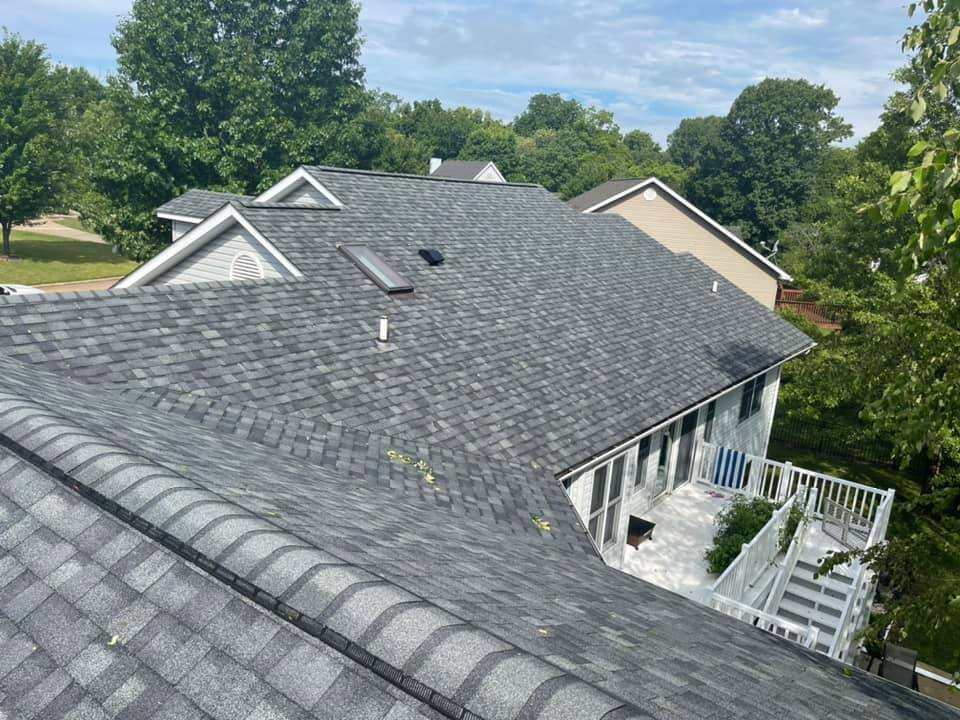Proper asphalt shingle installation is key to protecting your home from the elements and extending the life of your roof. In regions like Edwardsville, IL, where wind, rain, snow, and sun can cause wear over time, a well-installed asphalt shingle roof provides long-term protection. At Michael Ryan Exteriors – Roofing Professionals, we specialize in asphalt shingle roofing backed by many years of industry experience. A correctly installed asphalt shingle roof not only increases home value but also reduces long-term maintenance. This shingle installation guide will walk you through the top roofing best practices that help homeowners maximize their roof longevity.
Asphalt shingles are one of the most widely used materials in the roofing industry. Their popularity stems from their affordability, weather resistance, and range of design choices. As mentioned by Asphalt Roofing Manufacturers Association (ARMA), there are three reasons why asphalt shingles can be found atop more than 80 percent of American homes: Beauty, Affordability, and Reliability.

Asphalt Shingle Roofing: Affordable, Durable, and Built for Every Season
Asphalt shingle roofing remains a top choice for homeowners seeking a balance of affordability, durability, and year-round performance, making it a smart investment for homes across Illinois and beyond.
1. Asphalt Shingles: Quality Roofing That Fits Every Budget
Affordable asphalt roofing shingle prices make them accessible for homeowners on any budget. Asphalt shingles are typically more cost-effective than other roofing materials, such as metal or slate. Even high-performance types of asphalt shingles remain competitively priced while offering enhanced features. Their lower installation costs and widespread availability also contribute to overall savings. Because they require fewer specialized tools and less labor than premium materials, homeowners can often reduce project timelines. This combination of affordability and proven reliability has made asphalt shingles one of the most widely adopted roofing options.
2. Types of Asphalt Shingles: Finding the Right Fit for Your Home
Asphalt shingles are generally categorized into three main types: 3-tab, architectural (also known as dimensional or laminate), and luxury (sometimes called premium or designer). Each type differs in style, cost, durability, and warranty coverage. Architectural shingles, for example, provide a dimensional look and better wind resistance. Homeowners can choose from various textures and colors to complement their home style. Three-tab shingles are ideal for budget-conscious projects, offering a clean, uniform appearance. Premium shingles, often designed to mimic natural materials like slate or wood, add visual sophistication while enhancing durability. This broad selection allows property owners to balance aesthetic goals, budget constraints, and climate demands with confidence.
Modern energy-efficient asphalt shingles feature reflective coatings that deflect more sunlight and absorb less heat than traditional shingles. This helps limit indoor heat buildup and can reduce cooling costs during hot weather. Improved cool asphalt shingles with higher SR (about 0.40) and lower cost (comparable to standard, non-cool shingles) could save up to 50% more energy per unit roof area than the current generation of cool asphalt shingles, and more readily penetrate the residential roofing market.
3. Extending the Life of Your Asphalt Shingle Roof
Proven asphalt shingle roof life of 20 to 30 years with proper care. Longevity depends on both product quality and professional installation practices. Regular maintenance, such as gutter cleaning and visual inspections, also helps extend the life of the roof. Factors such as proper attic ventilation and moisture control can also influence the overall lifespan of the roofing system. High-quality underlayment and flashing details help prevent leaks and structural damage over time. By following industry-recommended roofing best practices, homeowners can greatly extend the functional life of their asphalt shingle roof.
4. Reliable Performance Through Every Season
Effective performance in varying Illinois climates. Asphalt shingles are designed to withstand harsh weather, including wind, rain, and snowfall. Their flexibility and durability help prevent cracking or warping during seasonal temperature shifts. This makes asphalt shingle roofing an ideal choice for the Midwest. Asphalt shingles also perform well against UV exposure, reducing the risk of premature aging or discoloration. Many asphalt shingles are rated for impact resistance, providing added protection during hailstorms. Their reliable sealing technology helps minimize the risk of water intrusion and mold growth in high-moisture environments.
What Every Homeowner Should Know Before Installing Asphalt Roofing
Key Steps in the Planning Phase
- Inspection: Identify any damage or deterioration in the existing roof. A proper evaluation helps determine if the roof can be repaired or if a full replacement is needed. Professional inspections reveal hidden issues that may compromise new shingle performance. Michael Ryan Exteriors offers no-cost roof evaluations to help homeowners start the process confidently.
- Material Selection: Choose the best types of asphalt shingles for your property. Different shingles offer varying levels of thickness, wind resistance, and curb appeal. Matching your selection to local climate and home architecture is key. A contractor can recommend options that balance performance and visual style.
- Permit Check: Verify compliance with local codes. Most roofing projects require municipal approval before work begins. Failing to secure permits can delay your project or result in fines. Reputable contractors handle this step on your behalf to streamline the installation process.
- Estimate: Get a professional estimate for asphalt shingle fitting and installation. A detailed quote helps plan your budget and avoid surprise costs. It should include materials, labor, timelines, and warranty terms. Michael Ryan Exteriors provides straightforward estimates with transparent pricing.
Best Practices for Installing Asphalt Shingles
Following the right techniques during installation is critical. Below are industry-approved best practices for durable asphalt shingle roofing.
1. Roof Deck Preparation for Asphalt Shingle Installation
Before installing new asphalt shingles, it’s critical to start with a properly prepared roof deck to support long-term performance and durability.
- Remove all old materials to expose clean decking. This provides a stable foundation for new shingles to adhere securely. Leaving old layers can hide moisture damage or cause uneven installation. Michael Ryan Exteriors always starts with a clean slate to maximize performance.
- Replace damaged or rotted sections to support the new asphalt shingle roof. Weak or soft decking compromises the structural integrity of your roof system. Replacing damaged areas prevents sagging and supports the weight of shingles and snow loads. Deck repair is one of the most important roofing best practices.
Pro Tip: Don’t Mix Shingle Batches
Always check that all asphalt shingles come from the same lot number. Slight color differences between batches can cause a patchy look once installed. Contractors like Michael Ryan Exteriors verify product consistency before beginning the job. Uniform shingles improve your roof’s appearance and resale value.
2. The Impact of Underlayment on Asphalt Shingle Roof Longevity
Underlayment is an integral layer that enhances both the protection and longevity of an asphalt shingle roof.
- Moisture Protection: Felt or synthetic underlayment provides a critical secondary barrier against moisture intrusion caused by wind-driven rain, snowmelt, or ice dams.
- Backup Defense: In cases of shingle damage or displacement, the underlayment acts as a reliable safeguard, helping to prevent leaks and water damage to the underlying roof deck.
- Improved Shingle Fitting: A smooth underlayment layer enhances the surface for better asphalt shingle installation, supporting a tighter and more uniform seal.
- Roof Longevity: Properly installed underlayment extends roof life by maintaining protection through seasonal temperature swings and adverse weather.
- Enhanced Fire Resistance: High-quality underlayment materials can improve a roof’s fire resistance rating, offering added protection in high-heat or wildfire-prone areas.
3. Starter Shingles and Course Alignment for Accurate Installation
Precise starter shingle placement and alignment are key to long-term roof performance and durability.
- Apply starter shingles at the eaves to stop water infiltration. These specially designed shingles help protect the edges from wind damage and leaks. Without a starter course, the initial row of shingles is more likely to lift or curl. Proper edge protection improves the lifespan of your asphalt shingle roof.
- Use chalk lines to maintain straight courses for better asphalt shingle fitting. This method helps create uniform rows and neat, aligned shingle placement. Straight lines also help in preventing stagger errors that may lead to water penetration. Experienced installers rely on chalk guides to maintain visual consistency.
4. Proper Nailing: The Key to a Durable Asphalt Shingle Roof
Proper nailing is key to achieving the strength, durability, and weather resistance of an asphalt shingle roof.
- Place 4 to 6 nails per shingle, depending on wind exposure. Following manufacturer guidelines helps improve wind resistance and reduces blow-offs. Using the correct number of nails is important for keeping each shingle anchored during storms. Nails should be corrosion-resistant to prevent rust stains and damage.
- Nail in the designated nailing zone to prevent blow-offs. Shingles have marked nail areas for a reason; nailing too high or too low weakens the hold. Nail placement affects how the shingles interlock and seal to each other. Michael Ryan Exteriors trains every crew member in these best practices.
5. Flashing Installation Techniques for Durable Asphalt Roofs
Flashing is important in asphalt shingle roofing to prevent leaks at joints and roof penetrations.
- Install flashing at valleys, chimneys, and sidewalls. These areas are prone to leaks if not sealed properly. Metal flashing is shaped and secured to guide water away from vulnerable intersections. Sealants may be used in conjunction with flashing to enhance water resistance.
- Use metal flashing with sealant to direct water away from joints. Flashing should extend several inches under shingles to channel runoff safely. Sealants must be compatible with roofing materials to prevent deterioration. The correct installation of flashing contributes greatly to roof longevity.
6. The Importance of Ventilation and Ridge Cap Shingles
Ventilation and ridge capping are vital final steps that enhance both the durability and appearance of an asphalt shingle roof.
- Ventilation and ridge capping are critical final steps in asphalt shingle roof installation. These components not only enhance roof appearance but also play a key role in regulating temperature, preventing moisture issues, and supporting overall system longevity.
- Install exhaust and intake vents to allow airflow. Proper ventilation helps regulate attic temperature and reduces moisture buildup. It also prevents ice damming in winter and lowers cooling costs in summer. Continuous airflow preserves both the roof structure and shingles.
- Add ridge cap shingles at the peak to seal the roof and improve appearance. Ridge caps protect the top seam from wind and water entry. They also provide a polished look that matches the rest of the asphalt shingle roofing system. Pre-formed ridge shingles provide consistency and durability.
Pro Tip: Maximize Asphalt Shingle Performance with Proper Ventilation
Proper attic ventilation extends the life of asphalt shingles by minimizing heat and moisture buildup. In winter, it helps prevent ice dams that can damage the roof edge. In summer, it keeps shingles from deteriorating due to trapped heat. Balanced airflow between intake and exhaust vents is a must for long-term performance.
Identifying and Preventing Common Mistakes in Asphalt Shingle Installation
Avoiding common asphalt shingle installation mistakes is key to preventing costly repairs and maintaining long-term roof performance.
- Incorrect nailing placement: Nails driven too high can cause shingles to slip, while nails placed too low can expose the nail head to water. Both issues lead to premature roof failure. Proper training in nailing patterns is critical.
- Skipping underlayment: Skipping this step removes the secondary barrier that helps keep moisture out. A roof without underlayment is vulnerable to leaks during heavy rain. Underlayment is especially important in regions with snow and ice.
- Inadequate flashing: Without secure flashing, water can seep into joints and cause rot or mold. Flashing is necessary around all roof penetrations, including vents, skylights, and chimneys. Poorly installed flashing is one of the top causes of roof leaks.
- Poor ventilation: Lack of airflow causes moisture to accumulate in the attic, weakening wood supports and encouraging mold. It also reduces the life of the shingles due to heat buildup. Balanced ventilation systems are a must for every roofing project.
- Misaligned shingle rows: Uneven shingles not only look unprofessional, but they also allow wind-driven rain to enter between gaps. Crooked rows can compromise the entire waterproof barrier. Use alignment tools like chalk lines for accurate layout.
Roof Maintenance Tips to Extend Asphalt Shingle Roof Life
Routine maintenance plays a key role in extending the life of your asphalt shingle roof.
- Clear leaves and branches from the roof surface: Debris can trap moisture and add unnecessary weight to the roof. Removing it helps prevent algae growth and shingle deterioration. Regular cleaning also makes it easier to spot signs of damage.
- Clean gutters twice a year: Clogged gutters prevent proper drainage and can cause water to back up under shingles. Overflowing gutters may also lead to fascia damage and foundation problems. Fall and spring are ideal times to perform this task.
- Schedule seasonal inspections: After each season, especially winter and storm seasons, check your roof for wear. Look for missing shingles, flashing damage, and soft spots. Early detection helps prevent larger and costlier repairs.
- Check for loose shingles and missing granules: Granule loss is a sign of aging shingles and reduces UV protection. Loose shingles can be resecured before they blow away or cause leaks. Use binoculars or hire a pro for safe inspection.
- Prevent ice dams in winter with proper insulation: Ice dams form when warm attic air melts snow, which then refreezes at the eaves. This buildup can lift shingles and allow water underneath. Insulation and ventilation work together to stop this problem.
Pro Tip: Inspect After Every Major Storm
Even if your roof looks fine from the ground, hail or high winds can damage shingles or loosen flashing. Schedule a quick inspection to spot minor issues before they grow. Michael Ryan Exteriors offers free post-storm checks for area homeowners. Regular inspections help maintain roof warranties and performance.

Quality Asphalt Shingle Roofing by Michael Ryan Exteriors
Installing asphalt shingles correctly is more than just a construction task; it’s an investment in the long-term protection, appearance, and value of your home. At Michael Ryan Exteriors in Edwardsville, IL, we combine craftsmanship, certified materials, and personalized service to deliver high-performance asphalt shingle roofing that stands the test of time. From Glen Carbon to Edwardsville and Troy, homeowners trust our team for dependable asphalt shingle roof installations. We focus on transparency, detailed inspections, and customized roofing solutions designed to meet the specific needs of each property, not one-size-fits-all approaches.
Ready to extend the life of your roof with expert installation and durable materials? Contact Michael Ryan Exteriors today for a free roof inspection or estimate. Call us at (618) 600-3490 or email office@MichaelRyanExteriors.com to schedule your consultation. Let our experienced team help you protect your home with professional-grade asphalt shingle roofing designed for long-term performance.



